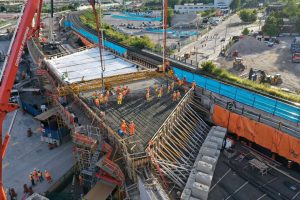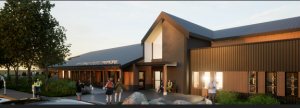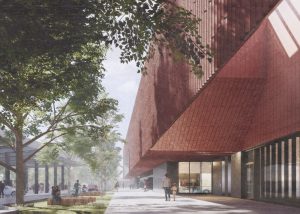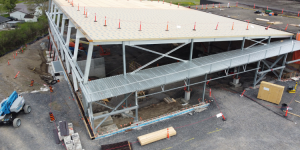When architect Gerry Pilon spoke to a full room of contractors, owners, engineers and architects, his message was that meaningful collaboration between the design-build team members and the owner can significantly bump-up LEED points.
Pilon, owner of Barrie, Ont.-based Salter Pilon Architecture, was a featured speaker at the Canadian Design-Build Institute’s 2014 Conference, held in Victoria in October.
With a theme of "Design-Build: Maximizing Collaboration and Innovation," Pilon outlined how his project went from 39-point LEED Gold to 48 points for LEED Gold.
"Where we started and where we got to kind of morphed itself along the way," Pilon said.
While enticing, getting four more points to reach 52 and LEED Platinum, would have been too cost-prohibitive, he told the 140-person audience.
The $43.1-million project, for the City of Ottawa, was to build a 95,000-square-foot, two-storey recreation centre, with an eight-lane pool, fitness centre, two gyms, office and meeting rooms and yoga studio.
The contractor was Bondfield Construction.
In the "old days," projects were built at the cheapest cost, but for the Richcraft Recreation Complex, the owner set aside extra funds for ideas created via collaboration, Pilon said.
"At the start, the owner had clear objectives for what was to be achieved," he said.
LEED requirements were important but the owner was also willing to investigate other items of value. Design started in August 2011.Construction began in December 2011.
The facility, one of Ottawa’s greenest buildings, opened in December 2013, on time and on budget.
As construction got underway, it quickly became clear to Pilon and the team that in certain LEED categories, like Sustainable Sites, it would difficult to maximize points.
The 15.4-acre site had a hydro easement running through the middle, it was heavily wooded and there was minimal stormwater capacity.
But in the Water Efficiency and Innovation and Design Process categories, frank discussion helped achieve 5/5 in each category.
One challenge was that the owner wanted meaningful community engagement, so the design-build team had to work with a community consultation team. Members of the public made many suggestions about what they wanted in the facility.
"Lots of things came out of that. It drove what we did. It showed that we were listening through the process," Pilon said.
So, the plans became a dynamic document, incorporating changes such as installing a window system that ensured onlookers wouldn’t see Muslim women when they were using the swimming pool to meeting with skateboarders to design the skateboard park.
To surmount the changes, collaboration became key.
"It all became about communication," Pilon said.
A daily communication protocol was established, with updates of the day’s previous work discussed.
"It’s common sense to communicate early and regularly," he said.
Design-built team meetings were held bi-weekly to discuss work such as the installation of a geothermal system, which added about $800,000 in costs but is on track to generate $105,000 in energy savings annually, as well as the use of grey water to flush toilets and urinals (reducing water consumption by 40 percent).
When the project started, it seemed that the typical design-build method of "drive it through and deliver" might have taken hold, Pilon said.
But as the project progressed, the robust engagement between the owner, community and design-build team improved the project while not going over budget.
"Without the dialogue, it would have been a normal design-build," Pilon said.











Recent Comments
comments for this post are closed